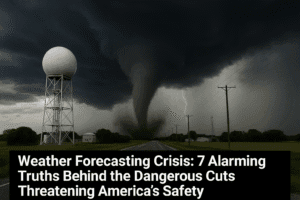Weather Forecasting Crisis: 7 Alarming Truths Behind the Dangerous Cuts Threatening America’s Safety
The July 2025 flash floods in Texas, which killed over 130 people, spotlight a growing crisis in U.S. weather forecasting as the National Weather Service (NWS) faces severe staffing cuts. Though experts agree the NWS performed well during this disaster, deeper concerns remain. Nearly 600 positions have been lost in 2025 alone, leaving local forecast offices critically understaffed. While the Texas NWS office issued timely alerts, such resilience may not be sustainable.
Chronic overwork, reduced atmospheric data collection, and unfilled specialist roles are weakening America’s forecasting infrastructure. As climate change drives more extreme weather, the demand for timely, accurate warnings is rising—while resources dwindle. Budget cuts threaten not just forecasts, but lives, with lawmakers warning that a “leaner” system could result in missed warnings and delayed responses. Investing in weather forecasting isn’t optional—it’s essential for national safety in a more volatile climate future.

Weather Forecasting Crisis: 7 Alarming Truths Behind the Dangerous Cuts Threatening America’s Safety
The devastating Texas Hill Country flash floods of early July 2025, claiming over 130 lives, cast a harsh spotlight on a simmering concern: the state of America’s weather forecasting capabilities. Amidst the rescue efforts and grief, a critical question echoed – did recent staffing cuts at the National Weather Service (NWS) hamper warnings for this disaster? While experts largely say “no” for this specific event, the underlying story reveals a precarious system facing a gathering storm of its own.
The Cuts: Not Just Future Plans, But Present Reality
The headlines focused on the Trump administration’s proposed 25% cut to NOAA’s $6.1 billion budget for Fiscal Year 2026 (starting October 2025). However, the NWS, NOAA’s vital forecasting arm, has already undergone significant downsizing:
- 600 Positions Lost: Through voluntary buyouts, early retirements, and firings, the NWS has lost approximately 600 staff members from its workforce of about 4,200 since the start of 2025.
- Widespread Impact: As of April 2025, nearly 20% of staff were gone from 122 local NWS forecast offices nationwide.
- Critical Vacancies: Key roles, including meteorologists and science officers, remain unfilled even in offices directly responsible for high-risk areas.
Texas Floods: A Test Case with Complex Answers
Did these cuts contribute to the Texas tragedy? A closer look suggests a more nuanced picture:
- Forecasts Were Issued: The NWS office in New Braunfels, TX, issued critical “Flood Watch” warnings more than 15 hours before the disaster hit Kerr County and others, escalating to “life-threatening flash flooding” alerts.
- Surge Staffing Activated: For this specific event, the office operated with five forecasters instead of the usual two, mitigating immediate staffing shortfalls.
- Expert Consensus: Independent experts like Avantika Gori (Rice University) and Chris Vagasky (meteorologist) confirmed forecasts and warnings functioned normally. The challenge lay in predicting the extreme, localized nature of the rainfall – a known forecasting difficulty even with full resources.
President Trump asserted the cuts played no role, calling the floods an unforeseen event happening “in seconds.” While staffing wasn’t the primary culprit this time, experts and lawmakers like Senator Schumer and Representative Wasserman Schultz raise urgent flags about the future.
The Looming Forecast: Reduced Staff, Rising Risks
The real danger lies not in a single missed event, but in the systemic erosion of resilience:
- Chronic Overwork: Remaining staff are stretched thin, often working consecutive day and night shifts. Fatigue increases the risk of human error – a missed detail, a delayed warning – during complex, high-pressure events.
- Degraded Data Collection: Staffing shortages have already forced a reduction in weather balloon launches. These balloons provide essential atmospheric data crucial for accurate forecasts, especially for developing severe weather. Fewer launches mean lower-quality initial data feeding into models.
- Vacant Expertise: Unfilled specialist roles (meteorologists, science officers) mean less capacity for nuanced analysis, model interpretation, and refining warnings during evolving threats.
- Climate Change Amplifier: As climate change fuels more frequent, intense, and unpredictable extreme weather (like record rainfall and flash floods), the demand for more sophisticated forecasting and more staff is increasing. The current trajectory is the opposite.
The Human Cost of a “Leaner” System
The argument for budget cuts often centers on efficiency. However, in weather forecasting, “efficiency” achieved through deep staffing reductions translates directly into heightened risk:
- Slower Response: Overburdened offices may struggle to analyze rapidly changing conditions as quickly.
- Less Precision: Reduced data and expertise can lead to broader, less specific warnings, potentially causing “warning fatigue” or failing to pinpoint the highest-risk zones.
- Missed Opportunities: Subtle indicators of developing severe weather might be overlooked by exhausted staff managing multiple tasks.
Conclusion: Investing in Forecasts is Investing in Lives
The Texas floods were a tragic natural disaster. The NWS, despite being stretched thin, performed its duty effectively in that instance. However, the event serves as a stark warning sign for what lies ahead if the erosion of America’s weather forecasting infrastructure continues.
Maintaining a robust, well-staffed NWS isn’t a bureaucratic expense; it’s a critical investment in public safety. As Representative Wasserman Schultz starkly warned, pushing experts out the door means “people will needlessly die.” The proposed deep budget cuts for FY2026 threaten to accelerate this dangerous trend, leaving communities across the US increasingly vulnerable to the next storm, flood, or heatwave. The true cost of these cuts won’t be measured just in dollars, but in the lives they put at unnecessary risk in an era defined by escalating climate extremes. The forecast for the future of US weather safety, under current plans, looks increasingly hazardous.
You must be logged in to post a comment.